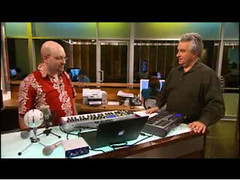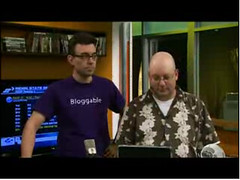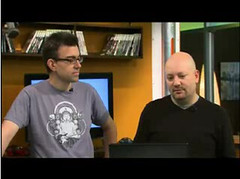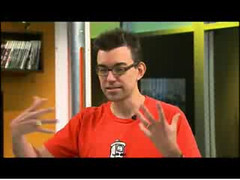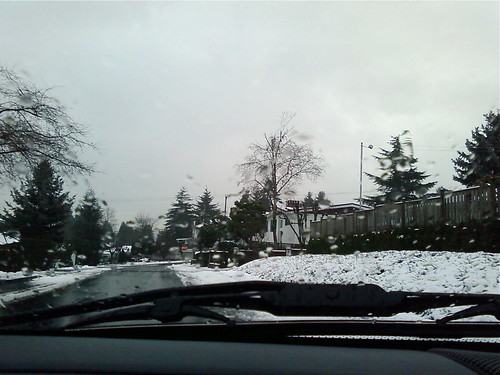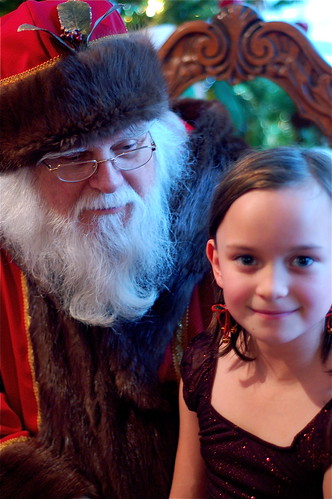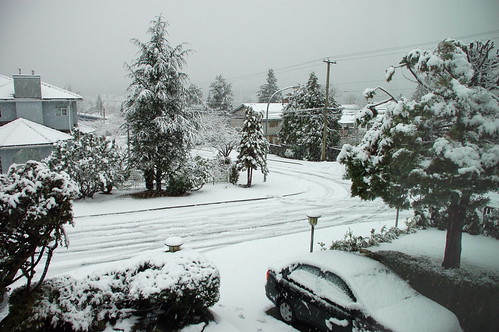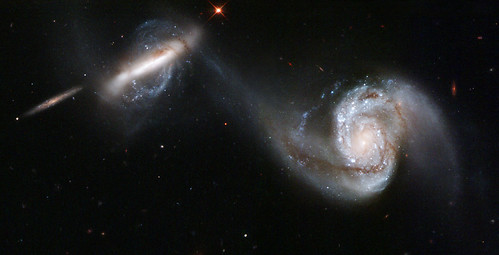Penmachine
31 December 2007
Hell of a year
 Some good things happened in my life in 2007. My kids took their first trip to Disneyland, and at the same time I made my first visit to the NAMM Show next door, which is like Disneyland for music geeks. I finally saw The Police in concert. My wife threw me a great birthday party. One of my best friends became pregnant with her first child, due in February 2008.
Some good things happened in my life in 2007. My kids took their first trip to Disneyland, and at the same time I made my first visit to the NAMM Show next door, which is like Disneyland for music geeks. I finally saw The Police in concert. My wife threw me a great birthday party. One of my best friends became pregnant with her first child, due in February 2008.
But otherwise it's been pretty rough. Back in January 2007, I first got my cancer diagnosis, and since then I've had four surgeries (one major), two rounds of chemotherapy (the second one is half-way over now), six weeks of daily radiation treatments, and almost a month in hospital, during which I dropped down more than 50 pounds below my normal weight.
To top it off, the year ended with the deaths of my mom's longtime friend, world figures Oscar Peterson and Benazir Bhutto, and my friend Martin, whom I'd known for more than 20 years. All role models, all flawed in their ways.
NOTE: I've now set up a memorial page for Martin, including links to articles about him, copies of the notes from his eulogy speakers, and photos from his memorial event on January 6, 2008.
And yet. And yet.
I have two very different yet wonderful daughters now approaching adolescence, and a wife who is by far my best friend and confidant. I have faced death and, so far, beaten it back. I have things I yet want to do, but also know that if I don't get to do them, I'm satisfied with what I've already accomplished in my life.
I'm glad to see 2007 gone, no doubt. I'm more optimistic now to see the end of 2008 than I was at some times during this past year. I'm surprisingly clear in how I see my place in the world. That's something of a gift.
Next Sunday there will be a memorial for Martin, who did not see the end of this year. I've been asked to speak briefly about his modeming and BBS days. One thing I know of him is that he was always trying to find new ways to have fun, and to be happy.
In my mind, we all have our lives and our families and friends, and we each must try to be happy, because they are all we have. Happy 2008 to you.
Labels: bbs, cancer, death, family, friends, geekery, holiday
30 December 2007
Torture
Several years ago, before the 2004 U.S. election, I wrote about Guantanamo Bay, still for me the key symbol of the failure of American foreign and legal policy after the 9/11 attacks, although I have been encouraged that the country's courts and media have at least done some chipping away at the edges of its black hole.
A big issue this year has been allegations of government-endorsed torture by U.S. government personnel at Guantanamo and elsewhere. I think P.Z. Myers's take on the subject today is cogent:
When the U.S. government announces [its] support for torture, they aren't talking about intelligence gathering: they are simply saying "Fear us." They are taking the first step on the road to tyranny.
The real problem is that fear isn't a good tool to use in a democratic society. [...] Anyone who supports torture is a traitor to the democratic form of government...
This upcoming year will give Americans a chance, once again, to decide what kind of country they want to become, and whether that will be a different one, with Guantanamo and torture as a sad past to remember, not a poisonous legacy for the future.
Iraq, well, that's more complicated, isn't it?
Labels: americas, government, terrorism, war
29 December 2007
WordPress Automatic Upgrade is great, but you need web-fu if it goes wrong
 This site runs on Blogger, as it has for more than seven years, but if I were starting over again today I'd probably use WordPress. That's what I recommend to my friends and relatives, so that other sites I work with, such as Simon's, my wife's podcast (as well as her personal blog), and Inside Home Recording all use it.
This site runs on Blogger, as it has for more than seven years, but if I were starting over again today I'd probably use WordPress. That's what I recommend to my friends and relatives, so that other sites I work with, such as Simon's, my wife's podcast (as well as her personal blog), and Inside Home Recording all use it.
If you use the free WordPress.com hosting service, all maintenance and upgrades are handled for you by the fine folks who run it. But if, like me, you're reasonably geeky and need the extra customization available by running WordPress on your own server, the main hassle has been that, when a new version of WordPress comes out, upgrading the software involves:
- Backing up your installation.
- Downloading the latest version of WordPress.
- Deactivating all the WordPress plugins on your sever.
- Putting your website into Maintenance Mode (basically, activating a page that says, "Hold on, we'll be right back" to your web visitors).
- Uploading a whole ton of updated files to your server, usually in several stages so you don't accidentally overwrite any of your own customizations, plugins, or themes.
- Running an upgrade script to update the database.
- Taking the site out of Maintenance Mode.
- Checking to make sure nothing's broken.
I've gotten reasonably good at that, but it's still time consuming, especially for multiple sites. Today, while surfing around feeling gross from chemo side effects, I read about the Automatic Upgrade Plugin (via Scott Beale on Twitter). It does all of that stuff with only a few clicks.
I tried it on two websites without a hitch, even using the Automated Mode that avoids the multi-screen, "Here's the next step, CLICK HERE if you're sure you want to proceed" process—with hardly a hitch.
Then, confident, I proceeded to the third site, Inside Home Recording, again in Automated Mode, got almost all the way through, and encountered the dreaded "500 Internal Server Error" page. I tried rolling back to my previous installation of WordPress manually. No dice. I noticed even the IHR forums (which use different software) were dead, which was mysterious and a bit freaky. And when I tried putting a generic "Sorry I broke the site" HTML page at index.php or index.html at the root of the site, it still didn't work. Yikes! I'd blown up the whole website!
I had a hunch, and took a peek at the invisible .htaccess file. That's a plain old text file sitting on the IHR web server (which I think is in Texas). The ubiquitous Apache web server software it's running uses .htaccess as a list to answer the question, "What do I do with stuff on this machine when I sent it out to the Web?" It seems that either WordPress or the Automatic Upgrade plugin had added some extraneous stuff to the end of that file. I deleted the extra text and, bingo, IHR was back up.
Having rolled back to the older version of WordPress, I made sure I had proper backups again (I remind you, back up, back up, back up your stuff), then tried the Automatic Upgrade plugin once more, but this time in Manual Mode (i.e. confirmed each step). No problems on this second attempt, and IHR is spiffed up with the latest software release.
Elapsed time from upgrade to blow up to fix up? Less than ten minutes. Sometimes I'm glad I have some web-fu when I need it.
Labels: backup, blog, family, friends, geekery, insidehomerecording, lipglossandlaptops, podcast, software, web
Our appearances on "Lab With Leo" from 2007
Over the past year, my Inside Home Recording podcast co-host Paul Garay and I have appeared six times on tech broadcaster Leo Laporte's cable show The Lab With Leo, which films (or, uh, digitizes, I guess) here in Vancouver. All six appearances are now available on Google Video:
We recorded them two at a time, which is why you'll notice that we're sometimes wearing the same shirts in more than one show. And I was taking some serious painkillers during each episode (with luck you won't notice that), since we made the segments during my spring chemo/radiation treatments, as well as before and after my major surgery in the summer.
We hope to record more in 2008 as Leo's resident audio recording experts—without those distractions.
Labels: insidehomerecording, labwithleo, leolaporte, podcast, television, video
28 December 2007
Elevation
Here, this afternoon, is what Kingsway in Vancouver looked like just as we were driving up the long, slow hill into Burnaby—notice there is no snow at all:
Mere minutes later we near the crest of the hill near our house in Burnaby, and it looked this way:
We needed the extra grip from the snow tires to get up our steep driveway. In Greater Vancouver, a few metres of extra elevation make all the difference.
Labels: snow, vancouver, weather
27 December 2007
And so I cried
NOTE: I've now set up a memorial page for Martin, including links to articles about him, copies of the notes from his eulogy speakers, and photos from his memorial event on January 6, 2008.
I mentioned that yesterday, in the shock of hearing about the death of my friend Martin, I hadn't yet cried. That changed today, and what prompted my tears was something small that I'd seen earlier this week and forgotten about.
As I've done since 2003, just before Christmas on December 23, I had sent out a holiday e-card (a photo of my family) to several dozen of our friends, colleagues, and acquaintances. Martin was on the list. He had replied with a brief, somewhat mistyped Merry Christmas message and a mention of his upcoming planned New Year's party, sent from his BlackBerry.
The next day, long before I heard the news, I had read his reply among others from our friends, filed it away, and forgotten about it. Today, as the snow fell outside and I was deleting some of the bounced emails from defunct addresses on my e-card list, by chance I came across his message again. He'd sent it at 11:44 p.m. on the 23rd, and sometime between then and the time I first read and filed it on the 24th, he had died. It must have been one of the last messages he had sent. I went cold. It was like an email from a ghost.
That was too much, and I went into the bathroom and wept. I blew my nose. The tissue was bloody from the side effects of the chemotherapy that is keeping me alive. Not much later, I cried again on my wife's shoulder when I told her the story.
Tonight my daughters and wife and I had dinner with Simon, the friend who told me the bad news, on the lower slopes of the North Shore mountain where he and Martin and others had once shared a house—and where Martin had hosted my bachelor party in 1995, at the end of a night exploring empty storm drains under the City of West Vancouver. At dinner, Simon and my family and I drank a toast to our lost friend. We're still stunned, and we weren't sure what to say.
Since my post yesterday I've heard from several people to whom Martin was important. I realized that for many of us, he was a pivot in our lives, someone who, though he never reached age 40, affected the kinds of people his friends have become, and for the better. Perhaps that is what each of us should strive to do.
Labels: chemotherapy, death, family, friends
26 December 2007
Martin Sikes - 1968-2007
 I've been wondering how to write this blog post all day, or whether to do it at all. But it seems silly (not to mention out of character) to avoid, so I'll just see what comes out.
I've been wondering how to write this blog post all day, or whether to do it at all. But it seems silly (not to mention out of character) to avoid, so I'll just see what comes out.
UPDATE: This post originally had "1970-2007" in the title, which was wrong. I knew that in my head (Martin was born before me, in 1968), yet his Facebook profile said differently, and I used that. Details are easy to screw up. I've corrected the title after a note from our friend Johan.
I've also now set up a memorial page for Martin, including links to articles about him, copies of the notes from his eulogy speakers, and photos from his memorial event on January 6, 2008.
I heard this morning via a phone call from my good friend Simon that one of our mutual friends, Martin, died early in the day on Christmas Eve. While I didn't see much of him these days, I had known Martin for more than 20 years, since our days as BBS geeks in the early 1980s. We first met in person at Vancouver's Expo 86, at least a couple of years after I'd met him virtually online. He showed up at Expo with a shock of blonde dyed into his dark hair, and a Super 8 film camera with which he was making strange little time-lapse movies of everything he saw.
I can't confirm what details I've heard about his death, so I'll avoid repeating them in case anything is incorrect. His last Facebook update, from a week ago, talked about the snow on one of our local ski hills, from which he'd just returned. So his death seems to have been quite accidental, and certainly unexpected. While over the years it has happened to a few people I've known who were roughly my age, Martin is the first friend of mine to die, as far as I can remember.
He was a talented engineer who had recently "retired" (in his mid-30s) after making a bunch of money when his video game company was bought out. He seems to have spent much of his time since then DJing and organizing raves and other events. Maybe he'd spent some time riding freight trains, at which he was also an expert. Both of his parents and his daughter, now a young adult herself, have survived him.
Years ago Martin and I used to take mountain-biking trips together in the backcountry around Greater Vancouver. Engineer that he was, he brought the topographic maps (this was pre-GPS), and he was always hard to keep up with. We traversed the logging roads between Squamish and Indian Arm. He witnessed my worst-ever case of road rash, where I took a downhill on a logging road too fast and ended up sliding down the gravel on my side.
I've thought a lot about death this year. Having stage 4 metastatic cancer will do that. What's particularly strange about it is that Martin hosted a party for me on in June at his fabulous condo high up in a Yaletown tower, a few weeks before the big surgery that put me in hospital for most of July, and from which it took me months more to recover.
Yet here I am, still kicking, feeling as good as I have in all of 2007 despite my ongoing chemotherapy, and Martin is suddenly gone.
I haven't cried yet, but I still may. I came close when I saw my youngest daughter sprawled out asleep in bed as if she'd fallen from the ceiling, and it reminded me of Martin's daughter doing the same at a party about two decades ago. Mostly I distracted myself in a lazy post-Christmas day with my family watching TV (including a whole slew more of MythBusters), and late tonight I've been listening to a bunch of blues, plus the amped-up blues that is the latest White Stripes album. Jack White's Ph.D.-level guitar distortion helps draw the sadness out and cauterize it a bit.
Part of me feels it slightly unseemly to write this, since I'm not sure it's what his family and closer friends would want. Yet I hope they don't mind, because not writing it wouldn't be right either, like a hole in this blog—always a very personal place for me—where something important should be.
I'm not one to speak or write to the dead, as many are doing on Martin's Facebook page. I don't think he's anywhere to hear me anymore. I'll simply say that, as little as I saw Martin in recent years, I miss him with his twinkly eyes and off-kilter funny techie stories. I know many other people who surely do too. Together our memories will preserve what was best about him.
Labels: bbs, cancer, death, friends, geekery, memories, music, vancouver
25 December 2007
Ho ho ho!
24 December 2007
Merry Christmas everyone
From my youngest daughter, Santa Claus, and the rest of us here in my Great White North family, Merry Christmas.
Have a happy hoho!
Labels: family, friends, holiday, vancouver
23 December 2007
Swingin' holiday classics
 If you're still looking for some good Christmas music for the 24th or 25th, I recommend the new Colin James album Christmas, made with his Little Big Band. (It may only be available in Canada for now.)
If you're still looking for some good Christmas music for the 24th or 25th, I recommend the new Colin James album Christmas, made with his Little Big Band. (It may only be available in Canada for now.)
Colin lives here in Vancouver, and his sometime bassist Doug Elliott also plays with my band, but that's not why I recommend it. Christmas is the latest in a long series of Little Big Band projects stretching back to 1992, and Colin has a deft way with the jump-blues guitar-horns-organ format, which he revived long before Brian Setzer.
What that means is this album, though it contains both traditional chestnuts ("I'll Be Home for Christmas," "Let It Snow," "Baybe It's Cold Outside") and some swingin' alternatives ("Cool Yule," "Boogie Woogie Santa Claus," the gospel-style "Go Where I Send Thee"), is remarkably refreshing in the sea of sappy-sweet versions you hear this time of year. Colin swings and shimmies and leaves a smile on your face. If that sounds up your alley, pick it up.
Labels: band, colinjames, holiday, music
22 December 2007
Uh, Happy Solstice again
Mark pointed out that my post yesterday was slightly wrong; the Winter Solstice was actually last night (not the night before), or this morning if you're on Eastern Time. For a demonstration of the contrast in weather, here's what it looks like right now in Vancouver:
Unfortunately, it looks like it will all melt before Christmas. Maybe before sundown today.
Labels: family, holiday, science, snow, weather
21 December 2007
Happy Solstice
Here's a photo of the sun finally lighting up the wall of my daughters' school this morning. It was 8:53 a.m.—there's the Winter Solstice for you:
Labels: family, holiday, school, science, weather
20 December 2007
Last podcasts before Christmas
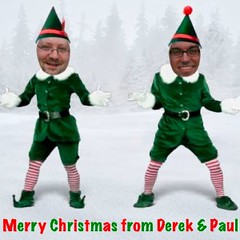 The latest episode of Inside Home Recording, the podcast I co-host, has just gone online in MP3 and Enhanced AAC formats. Go listen if you want to hear about nice headphones from Ultrasone, rockin' guitar sounds from Guitar Rig 3 software, or the black vs. silver debate.
The latest episode of Inside Home Recording, the podcast I co-host, has just gone online in MP3 and Enhanced AAC formats. Go listen if you want to hear about nice headphones from Ultrasone, rockin' guitar sounds from Guitar Rig 3 software, or the black vs. silver debate.
Also, if you like the background music that's part of my Guitar Rig 3 review, you can download that (it's called "Striking Silver" and is 12 minutes long) as an MP3. It's the first original instrumental I've posted to the Penmachine Podcast since "Fakeout" way back in February. But you know, it's been a busy year.
My wife's Lip Gloss and Laptops podcast posted their final show (MP3) of 2007 last week.
Yesterday evening I went to three different Christmas events, all with food. This week may have been about podcasting, but now it seems time to eat. And wrap. Ho ho ho.
Labels: guitar, holiday, insidehomerecording, lipglossandlaptops, music, penmachinepodcast, podcast
19 December 2007
How to take better Christmas photos
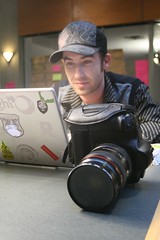 Our handsome pal Kris "kk+" Krug just did an interview on CBC Radio's On the Coast with lots of cool tips on how to take better holiday photos.
Our handsome pal Kris "kk+" Krug just did an interview on CBC Radio's On the Coast with lots of cool tips on how to take better holiday photos.
He knows how to take the pictures, so his advice is worth following. You don't need the big monster camera like his, by the way.
I'm also fond of the holiday eating tips ("If something comes with gravy, use it. That’s the whole point of gravy.") passed along by Arieanna, who also got an insanely huge Christmas tree this year.
Finally, don't forget the Mythbusters Christmas Rube Goldberg Machine:
It has Diet Coke and Mentos, as well as a holiday beef roast propelled right out of an oven. Thanks to my daughters for finding that one.
Labels: cbc, flickr, food, holiday, kriskrug, mythbusters, photography, radio, television
18 December 2007
The new world of shopping
I've ordered several of this year's Christmas presents online from the U.S., although none of them has arrived yet, which is a bit worrisome. Nevertheless, the current U.S.-Canadian dollar parity means waiting for Customs clearance is usually worth it.
For instance, I was looking for a particular present that I wanted to pick up today in town. No one had it in stock, despite several stores listing it on their websites. So I went to the manufacturer's online store in the U.S., and they were happy to take my order and ship it expedited to Canada, so that it may very well arrive before Christmas (no guarantees, though). And even with rush shipping and taxes, it was still several dollars cheaper than if I'd found it locally at retail.
My podcast co-host Paul has a post office box just across the border in Washington state (he lives in Cloverdale, B.C., about 15 minutes north of the line) which simplifies things even further: he can order from stores that don't normally ship to Canada at all, then pick up the stuff and deal with Customs himself. That saves him quite a bit of time and money—even when the dollar isn't as strong as it is now.
He does seem to be spending an awful lot more than he might otherwise on gadgets and gizmos across the border these days, though. I don't know if we're saving money in the end, or simply spending on more stuff.
Labels: americas, insidehomerecording, money, paulgaray, shopping, travel, web
17 December 2007
Shiny shiny
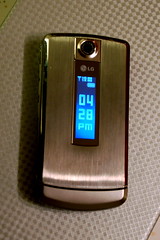 She could have waited until Christmas, but instead my wife made an early gift of it and had me pick myself a new mobile phone today. It's an LG VX8700, also known as the "Shine." Unlike my previous handset (the ancient LG 3200), it has a camera, memory expansion, outer lid screen, and Bluetooth, and it's metal.
She could have waited until Christmas, but instead my wife made an early gift of it and had me pick myself a new mobile phone today. It's an LG VX8700, also known as the "Shine." Unlike my previous handset (the ancient LG 3200), it has a camera, memory expansion, outer lid screen, and Bluetooth, and it's metal.
I know Roland "CDMA s*cks" Tanglao wouldn't agree with my choice of a non-smart CDMA phone instead of a cool Nokia-Symbian GSM device. But, quite differently than in other areas of my life, I'm not a phone geek. I have no interest in getting an iPhone, for instance. I probably wouldn't even have noticed that my old phone contract had expired if my wife hadn't pointed it out to me. I just want a phone that works, is reasonably rugged, makes and receives calls, gets decent reception, and can take a photo from time to time:
I've also stayed with Telus as my carrier for this phone, because unlike other parts of the company, their Mobility division actually seems to care about keeping loyal customers (I've been with them since 1998), and gave me a better deal on both the phone and my plan than new customers can get, plus threw in a free car charger.
Telus does cripple some of the Bluetooth functionality and other features of the phone, but I'll live with that for now. I don't want to use it as a modem, or for email or web browsing, especially at the usurious rates Canadian carriers charge for mobile data access. I've figured out how to get files to and from my MacBook via Bluetooth. I think the ringtone-purchase market is insane, but luckily there are several built-in ring options that sound like an actual telephone, so I'll use one of those.
The biggest annoyance? No way to transfer all my phone contacts over without re-entering them. Sigh. But the Shine still fits in the pocket of my carry bag (okay, okay, "man purse," as my wife calls it), which is a key consideration. Off we go.
Labels: gadgets, geekery, photography, telecommunications, telus
15 December 2007
Internet oldness
 It seems wrong that I've been blogging longer than Robert Scoble—and unlike him, you can still read my first post from 2000, which rolled in three years of website updates all the way back to 1997, ten years ago.
It seems wrong that I've been blogging longer than Robert Scoble—and unlike him, you can still read my first post from 2000, which rolled in three years of website updates all the way back to 1997, ten years ago.
Even that was almost seven years after I first connected to the Internet in 1990. My first BBS experience was in the spring of 1983. We're coming up on 25 years from that now. Yeesh.
Labels: bbs, excursionists, geekery, history, robertscoble
Last chemo before Christmas
This week was my fifth chemotherapy treatment of this cycle, which should end in the spring after my twelfth dose. I spent Wednesday evening, all of Thursday, and yesterday morning in bed. Friday afternoon a nurse at the Burnaby Health Clinic removed the bottle I wear for a couple of days, and I immediately started feeling better.
The timing works out well. It's two weeks till the next treatment, which means I'll be feeling pretty good through the crazy Christmas season—we have parties and events every day from the 20th through the 25th. Still a little bit of shopping to do too.
While I'd love to play with my band up in Whistler for New Year's Eve, that will take place right after my next dose, so there's no way it will happen. I'll just be here at home, and probably fall asleep well before midnight.
I'll certainly be glad to see the end of 2007, I tell you.
Labels: cancer, chemotherapy, holiday
14 December 2007
DCRP reviews the Nikon D300 camera
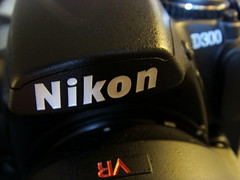 Jeff Keller's Digital Camera Resource Page has a full review of the new Nikon D300 digital SLR, posted today. I've always liked Jeff's reviews because they are both reasonably comprehensive and posted as a single long web page, which I much prefer to the multi-page versions offered at other camera review sites.
Jeff Keller's Digital Camera Resource Page has a full review of the new Nikon D300 digital SLR, posted today. I've always liked Jeff's reviews because they are both reasonably comprehensive and posted as a single long web page, which I much prefer to the multi-page versions offered at other camera review sites.
The D300 is Nikon's hefty $1800 mid-high range DSLR, aimed at somewhat spendy photo enthusiasts, as well as professionals who don't need the full-frame $5000 D3 (or who'll use it as a secondary camera for the D3). It's a huge step up from the introductory D40/40x (and the D50 before that, which I own) and mid-range D80 (or its D70/70s predecessors), and replaces the very capable D200. It competes most directly with Canon's EOS 40D and Sony's A700.
Jeff gives the D300 a rave review, nudging it ahead of the 40D (which is admittedly less expensive). The biggest differences are in low-light and high-sensitivity performance, and in the apparently amazing new high-resolution rear screen, which also offers live view (something like what you get on point-and-shoot cameras) for the first time on a Nikon SLR.
I'm still happy with my D50, since my semi-amateur photography doesn't generally push its limits, but the D300 also shows what features you can expect to see trickle down to the low end in a few years. The pace of change in digital photography is remarkable—while quality lenses will still last, the era of keeping a single main camera body for decades, as many people (including me) did in the days of film, is over.
Labels: gadgets, geekery, nikon, photography
13 December 2007
Getting a good baby passport photo, plus some pictures of bigger things
Two photo-related things today:
Passport photos for infants: little things
Passport rules have changed in the past couple of years in Canada, and now children, even infants, must have their own passports rather than riding along on those of their parents. That includes passport photos. For our kids that was no problem, since when we got them passports in 2006 they were already 6 and 8 years old. But I've been to a few photo stores and watched as parents and staff have some difficulty keeping their floppy-headed two-month-olds upright, looking at the camera, and reasonably calm in order to get an acceptable shot.
Yesterday I had some time to kill in the Vancouver neighbourhood of Kitsilano before my wife took me to my latest chemotherapy appointment, so I popped into the main store of Lens and Shutter to do some photographic geeking out. Their infant photography technique is smart: put a big white piece of cardboard on the floor, lie the child down on it, and have the parents stand behind the photographer to keep the kid engaged during the photo process. The little one I saw there was reasonably happy, kept his eyes open, and managed a reasonable passport photo in only a few tries.
My wife suggested I mention this as a useful tip. So if you have baby who needs a passport, go to Lens and Shutter or ask your local passport photographer to try a similar method.
Best astronomy photos: big things
Phil Plait at the Bad Astronomy Blog has posted the 2007 edition of his annual Best Astronomy Photos list. This year features more galaxies and fewer planets than the 2006 version. Look at this example:
NGC 3808A and NGC 3808B are several hundred million light years away, yet still we can see what they were up to back then. Wow.
Labels: astronomy, family, photography, science, travel
12 December 2007
Book Review: Why Beautiful People Have More Daughters
 When I read Why Beautiful People Have More Daughters (buy at Amazon Canada
When I read Why Beautiful People Have More Daughters (buy at Amazon Canada or Amazon U.S.
), I wasn't angry, but I was uncomfortable—and not because one of the authors of this brand-new volume has been dead for almost five years. The book is a summary of the new field of evolutionary psychology, which shows that our evolutionary past strongly influences how humans think and behave today.
UPDATE March 2008: It looks like the main author if this book, Satoshi Kanazawa, is a bit of a wingnut, and also may not be analyzing many of his statistics correctly. I stand by my review of the book here, but my reservations listed in it (especially that there is very little information about what many of the mechanisms of evolutionary psychology are) have become stronger with new evidence. Overall, I'm likely to look at his work more skeptically from now on.
You can see why that might be discomfiting: most of us like to think that we're independent actors, making decisions based on thought, and maybe influenced by our upbringing and our environment. Sometimes we are. But Alan S. Miller (the dead one, who got the project started) and Satoshi Kanazawa (the living one, who finished it) show how often we're not. If you're a creationist or think that all evil derives from patriarchal traditions and corporate media, this book will bug the hell out of you.
Publisher Peguin sent me the book to review at the suggestion of Darren Barefoot. Although my biology degree is a couple of decades old now, I find nothing in the fundamental premises of evolutionary psychology shocking. It only makes sense that, like those of all other animals (more so, since we depend so much on it), our human brain has evolved along with the rest of our body, adapting through natural selection to our environment.
Or, as Miller and Kanazawa point out, to what used to be our environment. We behave, make decisions, and organize ourselves the way we do today largely because it helped our ancestors survive and reproduce in Africa tens of thousands of years ago.
That's where things get interesting, and where the discomfort and controversy arise. Take this, from page 95:
Of course, diamonds and flowers are beautiful, but they are beautiful precisely because they are expensive and lack intrinsic value, which is why it is mostly women who think that diamonds and flowers are beautiful. Their beauty lies in their inherent uselessness; this is why Volvos and potatoes are not beautiful.
A major foundation of evolutionary psychology is that sex drives everything. Or, more accurately, that the differences between how men's and women's genes propagate to our descendants drives much of our behaviour, from the obvious (mating rituals) to the puzzling (wars, jobs, when we choose to travel, what we like to buy). We're just like dogs bred to be aggressive or good at herding sheep, or like birds and fish adapted to flocking and schooling, or predators that survive because natural selection molded their brains to know how to stalk and pounce and kill.
The result is many provocative statements about human beings:
- Divorced parents with children are playing a game of chicken, and it is usually the mother who swerves.
- Men do everything they do in order to get laid.
- Any reasonably attractive young woman exercises as much power as does the (male) ruler of the world.
- Clear evidence of women's promiscuity [...] is the size and shape of men's genitals and what men do with them.
- We believe in God for the same reason that men constantly think that women are coming on to them.
- It is the wife's age, not the husband's, that prompts [a man's] "midlife crisis."
- Religion is not an adaptation in itself but a byproduct of other adaptations. [...] The human brain [...] is biased to perceive intentional forces behind a wide range of natural physical phenomena [and thus] to see the hand of God at work.
- Humans are [...] born racist and ethnocentric, and learn through socialization and education not to act on such innate tendencies.
- Sometimes [a woman saying] "no" [to sex] really does mean "try a little harder."
Why Beautiful People Have More Daughters makes a reasonable case, with lots of reputable research backing it up, that much of the conventional wisdom of psychology and sociology is wrong. The authors and their evolutionary psychologist colleagues argue that many of the improper, cruel, unfair, and evil things (or, for that matter, altruistic, pleasant, equitable, and good things) that people do are not the result of childhood environments, cultural traditions, or power structures.
Rather, our behaviours today—whether our current ethics and morals judge them good or bad—are the same behaviours that helped our ancestors' genes propagate, and thus are the reason we're here now.
Men killing their wives, other men, and their stepchildren. Women wanting, and men liking, long lustrous blonde hair. Religiously motivated suicide bombers being almost exclusively young male Muslims. People of both sexes preferring blue eyes to brown. Women choosing older and more powerful men as mates, but more attractive men as lovers. Essentially all human societies permitting either polygyny (men with multiple wives or mistresses) or serial polygyny (men who marry, divorce, and remarry, usually to younger women). Young single women often traveling abroad to experience the world while their male cohorts tend to stay home and hate foreigners. All have explanations in evolutionary psychology, some more solid than others.
The writing in the book is sometimes a bit manic, as if the authors were yanking me as a reader from example to example, saying, "Look! Look! We're right again!" Some of their conclusions come with lots of convincing scientific evidence, not to mention theoretical predictions about human behaviour that turn out to be true. But others are apparently pure speculation. I also think many of their explanations would have been clearer using the past tense, rather than the present, to keep the role of our ancestral environment clear.
They do show that beautiful people tend to have more daughters, and why that makes sense, but the physiological mechanism of how it happens wasn't clear to me. And neither the authors nor their editors seem to know what "begs the question" is actually supposed to mean.
To be fair, Miller and Kanazawa take pains to note that many of the things we do make little sense in the modern world (meaning the fast-changing one we've been in for the past 10,000 years or so, since the invention of agriculture). But because those behaviours evolved over hundreds of thousands or millions of years before that, we can't help ourselves. And the authors also highlight some areas—homosexuality, declining birthrates in industrialized countries, the willingness to become a soldier—that their field can't explain very well.
We still love sweet and fatty foods, which were once rare and precious but are now overabundant and giving us health problems. Similarly, we behave in ways that begat us more children when living in small groups of hunter-gatherers in a sub-tropical savannah, but which may not be of similar benefit in a world of fast cars, 80-year lifespans, high explosives, supermarkets, birth control, jet travel, antibiotics, and Internet dating.
What made me uncomfortable about the book is that, as a bleeding-heart leftie, of course I want to believe that we are not so driven and constrained by our evolutionary history. But I'm also trained in biology and—even more after reading Miller and Kanazawa—it's clear to me that, like other animals, we must be.
But what we do is not always what we ought to do: Why Beautiful People Have More Daughters reinforces repeatedly that facts (what is) do not determine morals (what should be). As a parallel, knowing that fleas spread bubonic plague doesn't make the plague desirable, and knowing that is key to combating the disease. But, conversely, the way we think things should be isn't necessarily the way they are either. Wanting human nature to compel us to treat each other fairly and well doesn't make that true. We have to find different reasons to make it happen, to overcome much of what is innate in us.
That is yet another lesson of the modern world that my brain, prehistoric as it is, has trouble handling.
Labels: biology, books, controversy, evolution, naturalselection, psychology
11 December 2007
Not quite almost impossible
I managed a respectable 37 out of 58 (63.8%, or "Whiz") on Rolling Stone's Almost Impossible Rock 'n' Roll Quiz (via J-Walk). That surprised me, because the questions span the decades, and as is typical for someone like me, my musical tastes and pop-culture knowledge start to peter out around 1995.
Then again, it is Rolling Stone, not exactly the hippest of music magazines anymore. I was also surprised at some of the obscurities I knew, such as who first recorded Prince's "Nothing Compares 2 U."
And speaking of oldies, evidence from YouTube and Google Video indicates that Led Zeppelin (with Jason Bonham, son of deceased original drummer John) were in damn fine form yesterday. Check for "Kashmir," "Dazed and Confused," and the opener of "Good Times Bad Times" (always one of my Zep favourites) in particular.
Labels: age, band, ledzeppelin, music
10 December 2007
Surfing molluscs
 We have aquatic snails in our fish tank, rather by accident. They came in on one of the plants we bought for the aquarium, and they multiply like crazy.
We have aquatic snails in our fish tank, rather by accident. They came in on one of the plants we bought for the aquarium, and they multiply like crazy.
As someone who specialized in marine invertebrates for my biology degree, I rather like these little molluscs. They keep the sides of the tank spotlessly clean. They move surprisingly quickly (for snails). There are, however, often too many of them—they outnumber the fish by at least an order of magnitude—so we occasionally have to scoop some out and, uh, send them to greener pastures. (I have no doubt that things are greener, not to mention sludgier, in the Greater Vancouver sewer system.)
The snails perform one stunt that I hadn't seen before. Often they will make their way to the top of the aquarium and then "surf" upside down on the underside of the water's surface, riding the currents created by the tank filter. Sometimes one will circulate around for several minutes, its muscular foot flat against the surface tension, then it will either stick to a side or drift down to the gravel at the bottom to start trucking its way around again.
It's pretty cool, and probably the fastest these creatures will ever travel in their lives. Unless they get to visit the sewer someday, I guess.
Labels: biology, extremesports, family, fish, invertebrates
09 December 2007
Too much cheese
 On occasion I have told a story from my wife's and my honeymoon, which we spent driving around California in a rented Chrysler Le Baron convertible. One night, after visiting Knott's Berry Farm, we found a Mexican restaurant for dinner and ordered burritos.
On occasion I have told a story from my wife's and my honeymoon, which we spent driving around California in a rented Chrysler Le Baron convertible. One night, after visiting Knott's Berry Farm, we found a Mexican restaurant for dinner and ordered burritos.
They came, but we couldn't see them, because each one had what looked like an entire block of cheese melted on top. Even today I associate the sound of a Mexican pop band (there was one playing downstairs) with the sight of that mass of bubbling cheese.
Tonight my kids and I visited one of our local Pizza Hut restaurants (much closer than the one in the photo). We ordered the special: the Triple Cheese Explosion pizza, where not only is there cheese on the toppings, but the edge of the crust itself is injected with the stuff.
It was overload. After an appetizer, my older daughter ate about half of one substantial piece (including the cheesy edge), while my younger daughter ate only some toppings from hers. "Too much cheese!" she said. Her sister said, "Look, it makes the plate greasy." I ate a couple of slices, and the rest came home with us.
Next time I think we'll go back to Me-n-Ed's.
Labels: family, food, restaurant
08 December 2007
Startup no more
Last night was the Christmas party for Navarik, the company I've worked for since 2003, and for which I had the occasional contract in the three years before that. Several of my college colleagues founded it in 2000—a web software company started just as the web software bubble collapsed. It's about the same age as my younger daughter, or this blog.
Early on Navarik was the leanest of self-funded startup companies, with a tiny office where people were nearly stepping over each other and everyone could go for lunch around one table. Last night I looked around and realized that it is no longer a startup at all. The many employees who have been there nearly from the beginning are now seasoned veterans (with far more experience than, say, the folks who run Facebook; Navarik itself is several years older than Flickr and WordPress). We've brought in more seasoned veterans over the years to help run the place.
Pointedly, Navarik has hired more new people since I went on medical leave in February (and thus with whom I've never worked directly) than formed the entire company when I started. Some of them I'd never met until last night. Back in 2003 only a couple of us in the office had children; in the past two years there has been a substantial baby boom, enough that we're having another Christmas party next week, just for all the kids.
The business we do is not flashy or high-profile, though it requires considerable skill and intellectual effort. We help some very big companies move important, money-making information around. Our website needs updating to reflect what that means in 2007 (that's one thing that's not getting done while I'm away), but it is fundamentally the same vision that Bill, the company's founder, had while working in the marine bulk shipping industry in the late 1990s.
I'm itching to get well again and return to helping make that vision real. I joined Navarik more than four years ago not simply because my friends started it. Rather, I saw a company built on new technologies and ideas, created for the Internet, that could show important worldwide industries how to do better than the clumsier old world of traditional information technology.
That's not Web 2.0 hype, but a real business. And a strong one, I think.
Labels: cancer, holiday, navarik, software, web
07 December 2007
Is it real, or is it Mario Kart?
Okay, Speed Racer is going to be a movie you need to see on a big screen in a theatre, no doubt.
Normally I might dismiss all the eye candy as another lame-o Spy Kids 3D thing, but since the movie is coming from the Wachowskis, who created The Matrix, I'll give Speed Racer the benefit of the doubt. Whoa and all that.
It's interesting to see the Wachowskis try something very different in style—as well as almost certainly better than the definitively lame-o Matrix Revolutions. Be prepared for insane web buzz until the movie comes out next spring.
06 December 2007
Boilermaker
As often happens in Vancouver, our tap water is a little cloudy following the heavy rain and melting snow earlier this week. There is no boil-water advisory, as there was last year when this happened, however there is this:
Those with compromised immune systems due to HIV or who are undertaking chemotherapy [my emphasis - D.] or anti-rejection medications should always use drinking water that has been boiled or treated to the same level as boiling.
Damn, that's me, as my parents and wife pointed out. So no tap water for me. My immune measurements have been okay so far, but that can change—I've only had four of my planned twelve chemo treatments for this round.
Some people might take that, like advice to avoid drinking water in Mexico, as a good reason to have more beer or Scotch1 or something, but these days alcohol makes me feel almost instantly like crap, so it's bottled or boiled water and diet pop for me.
At least I can still take a shower. And go to my company Christmas party tomorrow. As designated driver.
1 Thank you again to everyone who came to my birthday party back in June and brought Scotch whisky as a gift. I have enough for several decades now, I think, especially at the rate I'm (not) drinking it at the moment.
Labels: cancer, chemotherapy, vancouver, weather
05 December 2007
Speaking of photo geekery...
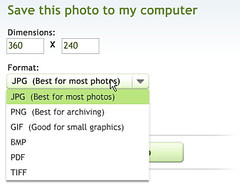 As of this morning, everybody favourite photo website, Flickr, has just teamed up with Picnik to let you edit your photos inside Flickr. That's big news.
As of this morning, everybody favourite photo website, Flickr, has just teamed up with Picnik to let you edit your photos inside Flickr. That's big news.
This is an especially important development (ahem) for the growing number of devices, from Wi-Fi enabled cameras and memory cards to mobile phones and beyond, that can send photos directly to Flickr without a computer intermediary. Until now in those cases, you could only use what limited retouching and editing capabilities were built into your device—if any—before your photos went online.
Now you can use an elegant and very Flickriffic interface to make lots of changes to your pictures (modify exposure and colours, remove red-eye, crop, etc.) from anywhere with any web browser, after you've posted them. Free.
Very slick. Picnik also offers Picnik Premium for $25 a year (the same cost as a Flickr Pro account), if you want more effects and editing capabilities. The free and premium services also work with other photo sites, by the way—today just adds an Edit Photo button right within Flickr.
Labels: design, flickr, photography, web
04 December 2007
Nikons vs. Canons
 In photo-geek cirlces, Canon vs. Nikon is something like the endless Mac vs. PC debates. They are the two heavyweight gorillas of the industry, especially in the market for digital single-lens reflex (DSLR) cameras, with everyone else—Pentax, Olympus, Leica/Panasonic, Sony/Minolta, Fuji, and so on—picking up what customers they can in the giants' wake.
In photo-geek cirlces, Canon vs. Nikon is something like the endless Mac vs. PC debates. They are the two heavyweight gorillas of the industry, especially in the market for digital single-lens reflex (DSLR) cameras, with everyone else—Pentax, Olympus, Leica/Panasonic, Sony/Minolta, Fuji, and so on—picking up what customers they can in the giants' wake.
However, unlike in computerland, any decent photographer, no matter how rabid about his or her preferred brand, would likely acknowledge that both Nikon and Canon produce excellent cameras and lenses, and if given one or the other to shoot with, could do a good job with only minimal transition time. Canon has dominated in both professional and amateur circles for the past couple of decades—whereas Nikon used to be the overwhelming pro favourite in the pre-autofocus era before that.
It's interesting that Japanese companies have dominated the camera market for so long (though of course they manufacture all but their top-end cameras and lenses in places like China and Thailand). Through the first half of the twentieth century, the companies that dominated compact cameras were American (Kodak) and German (Zeiss/Contax and Leica). Kodak and Leica are still making cameras, while Japan's Kyocera bought Contax some years ago, and stopped making Contax cameras in 2005. Zeiss remains a top-end, German-based lensmaker, supplying Sony and others these days.
But while Kodak continues a respectable business in the point-and-shoot market it created more than 100 years ago ("You Press The Button and We Do The Rest" was its catchphrase then), and Leica has a strong niche market among elite buyers, and in larger formats there are companies such as Sweden's Hasselblad (now also owned by a Japanese group), Japan has been the heart of the camera industry since at least the 1960s.
I've been a Nikon guy for 25 years, ever since I graduated from my dad's old Pentax SLR to a Nikon FG I bought for myself around 1982. I could just as easily have chosen Canon or Olympus or Pentax or Minolta then, but as it was I've kept a stable of Nikon lenses about during that whole time, which meant I've kept buying Nikon bodies to go with them.
For someone new to photography, the only simple way to tell Nikon and Canon SLRs apart is by reading the name badges on their pentaprisms, and to note that Nikon likes to include a red swoosh at the top of its camera handgrips. But for people who take lots of pictures, there are differences that we've grown accustomed to.
Nikon, for example, has used the same basic lens-mount design (the F-mount) since the 1950s, so even the newest Nikon SLRs support most Nikon-mount lenses ever made, especially those from the last 30 years, as well as lots of third-party lenses, even some swanky ones from Carl Zeiss in Germany. Canon, on the other hand, has changed its lens mount a few times to support newer technologies—the last major change (to autofocus) abandoned previous Canon lens designs, but enabled faster autofocus than Nikon could achieve, which is why the pros all moved over.
That's a big difference, but the little ones are important too. How the power switch works. Which finger you use for the adjustment dials. Where the buttons are, and what the different modes are called. Some photographers (me included) prefer Nikon's approach to ergonomics, but Canon's cameras generally look sleeker, especially at the high end. Most agree that Canon's lens caps kinda suck.
But you know what? For people just getting into digital SLRs, I think the best deal right now is the Pentax K10D. It offers things that neither Canon nor Nikon does, such as weather-sealing at an introductory-level price and in-camera shake reduction that works with any Pentax-compatible lens, not just those with shake reduction built in. Unless you expect to turn pro one day, that might be a great choice.
Labels: canon, gadgets, geekery, nikon, pentax, photography
03 December 2007
Most people have probably never seen snow
In a comment on one of my photos of the first real snowstorm of the season yesterday (it's almost all melted now, by the way), an Australian reader noted that he had never seen snow first-hand in his life.
That's a strange concept for any Canadian, but I started thinking about it and realized that not only did our hominid predecessors evolve in parts of Africa where it never snows, even today the great centres of human population—some of the most densely inhabited parts of China, the vast majority of India, Indonesia, almost all of Africa, the supercities of South America, and elsewhere—are also largely snow-free zones.
In other words, it has probably always been true that a big proportion, and likely the majority, of the human species has never experienced snow. And despite much easier travel, that is becoming more true as populations and climate shift. It's amazing that any number of us, from the Inuit, to the mountain dwellers of Peru and Afghanistan, to the bureaucrats in Ottawa, Vienna, and Ulan Bator, can handle the white stuff at all.
Does anyone have any data to back up my theory?
Labels: australia, environment, evolution, snow, travel, weather
02 December 2007
Hello December
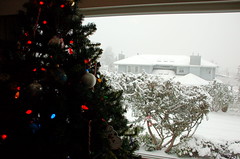 People from the rest of Canada often make fun of us here in the southwest corner of the country, where the weather is generally mild and we never face the kinds of minus-35°C blasts our brethren enjoy so much.
People from the rest of Canada often make fun of us here in the southwest corner of the country, where the weather is generally mild and we never face the kinds of minus-35°C blasts our brethren enjoy so much.
I do think, however, that this weekend's snowstorm, which has been coming down continuously since yesterday, counts as Actual Snow. We can't see the road or sidewalk or lawn, and the big fluffy flakes have built up a good 10 cm on some surfaces in our yard.
Typically, though, a sloppy wet tropical system is on its way to Vancouver from Hawaii or thereabouts, so it's all supposed to change to rain this afternoon and melt over the next couple of days. So we'll enjoy the prettiness today and slog through the muck tomorrow.
If you like, you can watch a time-lapse movie of our putting up the Christmas tree yesterday.
Labels: holiday, snow, vancouver, weather
01 December 2007
I like the mascots just fine
 In the last week, there has been the expected consternation among cynical B.C. adults about the new 2010 Vancouver Olympic mascots Sumi, Quatchi, and Miga (and mysterious hanger-on Mukmuk).
In the last week, there has been the expected consternation among cynical B.C. adults about the new 2010 Vancouver Olympic mascots Sumi, Quatchi, and Miga (and mysterious hanger-on Mukmuk).
I think they're reasonably cool, although there's no good reason a sasquatch (even a young one) should need earmuffs and boots, dammit. I think they're better than previous mascots (thanks to Scott at Facebook for the link), especially Canada's first, Amik, the 1976 Montréal plush lump that was supposed to be a beaver.
There does seem to be an early-21st century style developing, however—note the anime resemblance to the Fuwa mascots of the 2008 Beijing Games. Though maybe that doesn't carry over strongly to the plush and life-size versions.
What does bring out my cynicism, however, is having more than one mascot—that seems like a simple ploy to sell more stuff. If we had to pick one, I'd go with Quatchi: his "hey dude" slacker appearance, scratchy "why am I up before noon?" voice (check it out in Darren's unauthorized Olympic theme), and needless extra winter protection are very Vancouver. Though I guess if Sumi's oddball green tunic were Gore-Tex, that would do the job too.
Labels: olympics, shopping, toys, vancouver
